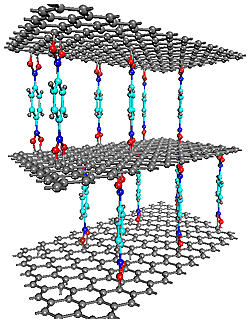Graphene - a form of carbon sheets with a one-atom thickness - is now emerging as a promising base material for hydrogen capture, according to recent research conducted by the National Institute of Standards and Technology in the US and the University of Pennsylvania. The findings show that stacks of graphene layers could safely store hydrogen for use in fuel cells and other applications.

The inspiration to make such an array came from metal-organic arrays that are also under rigorous scrutiny for hydrogen storage, and the team has only just begun to uncover the properties of the new material. "No one else has prepared such arrays to date, to the best of our knowledge," says researcher Taner Yildirim. "What we have discovered so far indicates that these arrays are capable of storing at least a hundred times more hydrogen atoms than normal graphene oxide is capable of. The easy synthesis, low cost and non-toxicity of graphene make this material a promising candidate for gas storage applications."
The new arrays are able to store about 196.15 percent of their weight as hydrogen at a temperature of minus 1.2 degrees Celsius and normal atmospheric pressure - compared to the XNUMX percent that metal-organic arrays that have been rigorously studied are able to store, the researcher notes.
One of the other interesting discoveries that the researchers found lies in the unusual relationship that the material exhibits between temperature and hydrogen adsorption. In most storage materials, the lower the temperature, the more hydrogen the material is able to absorb. However, the team discovered that their new array behaves quite differently - although it is still capable of adsorbing hydrogen, the material does not do so in significant quantities below a temperature of minus 223 degrees Celsius. Furthermore, it does not release any hydrogen below this "temperature barrier" - a fact that, after further research, could cause the material to both store hydrogen and release it - a necessary requirement in fuel cell applications.
Part of the material's capabilities lie in the self-adhering parts. The solvents the team used were all benzene-boronic acids that react strongly with hydrogen to themselves. However, by allowing a space of several angstroms between the graphene layers - similar to how pillars hold up the ceiling - the researchers also increased the available surface area of each of the layers, thus increasing the number of connection points available for the hydrogen bonds.
According to the researchers, the performance of the new material is yet to improve, once the team investigates its properties in more detail. "We intend to try and improve the material's performance and examine other binding agents, in addition," says one of the scientists involved in this research. "Also, we intend to examine the unusual relationship between the temperature at which the substance is found and the kinetics of hydrogen adsorption, as well as its ability to capture other gases, such as greenhouse gases such as carbon dioxide and toxic gases such as ammonia."

4 תגובות
*"The new arrays are able to store about one percent of their weight as hydrogen" - is this more relative to normal gas tanks?
"The new arrays are able to store about XNUMX percent of their weight as hydrogen" - is this more relative to gas tanks that regular users use?
Amit:
There is a connection but it is not the same.
graphite actually consists of many layers of Graphene.
Graphite has been produced for a long time, but separating it into layers is not easy.
Graphene = graphite?